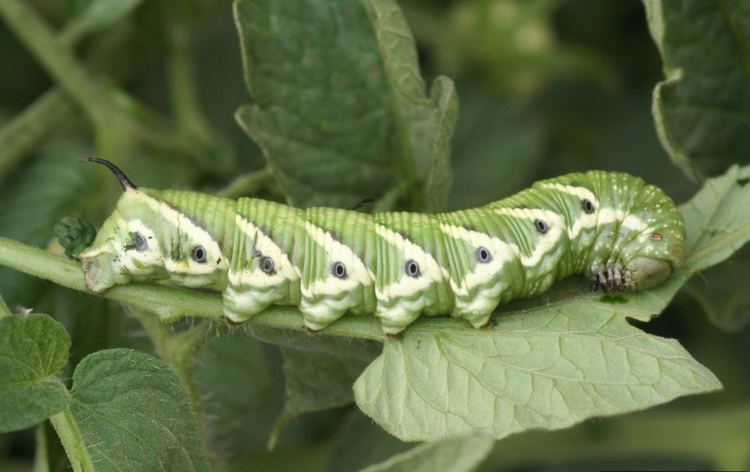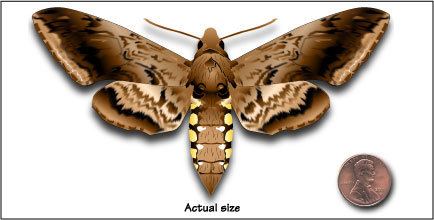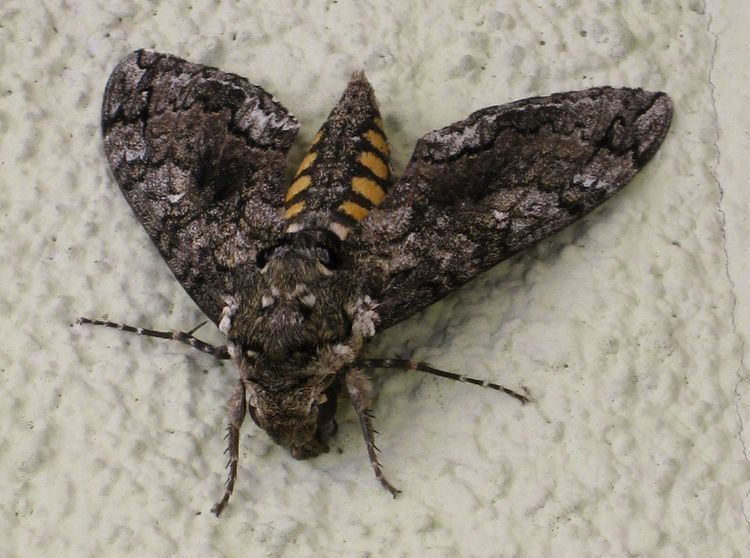Genus Manduca Higher classification Manduca | Scientific name Manduca quinquemaculata Rank Species | |
 | ||
Similar Tobacco hornworm, Manduca, Insect, Sphingidae, Butterflies and moths | ||
Five spotted hawk moth manduca quinquemaculata caterpillar
The five-spotted hawkmoth (Manduca quinquemaculata) is a brown and gray hawk moth of the family Sphingidae. The caterpillar, often referred to as the tomato hornworm, can be a major pest in gardens. Tomato hornworms are closely related to (and sometimes confused with) the tobacco hornworm (Manduca sexta). This confusion arises because caterpillars of both species feed on the foliage of various plants from the family Solanaceae, so either species can be found on tobacco or tomato leaves. Thus, the plant on which the caterpillar is found does not indicate its species.
Contents
- Five spotted hawk moth manduca quinquemaculata caterpillar
- Tomato hornworm caterpillar manduca quinquemaculata parasitized by braconidae wasp larvae
- Description
- Range
- Food plants
- Egg
- Larva
- Pupa
- References

Tomato hornworm caterpillar manduca quinquemaculata parasitized by braconidae wasp larvae
Description
The larvae of these species can be distinguished by their lateral markings: Tomato hornworms have eight V-shaped white markings with no borders; tobacco hornworms, on the other hand, have seven white diagonal lines with a black border. Additionally, tobacco hornworms have red horns; tomato hornworms have dark blue or black horns. Furthermore, the caterpillars can be distinguished from the larval stage onwards by the color of the horns on their back ends: M. quinquemaculata caterpillars have black horns, while M. sexta caterpillars have red horns. The moths can be distinguished by the number of spots on their abdomens, with M. quinquemaculata having, as its name suggests, five. Tomato hornworms grow as large as 4 inches (10 cm) in length, while the adults have a wingspan of 3.5 to 5.3 inches (8.9 to 13.5 cm).
Range

M. quinquemaculata is found throughout the United States, northwestern Mexico, and even southern Canada, but is less frequently found throughout the Great Plains and the southeast.
Food plants

Tomato hornworms are known to eat various plants from the family Solanaceae, commonly feeding on tomato, eggplant, pepper, tobacco, moonflowers and potato. Accordingly, they are often found on defoliated tomato plants, the caterpillar clinging to the underside of a branch near the trunk. They are difficult to spot due to their green coloration. Tomato hornworms fluoresce differently from tomato leaves. Using an ultraviolet light source of 375 nm and viewed behind a blue-blocking filter (yellow or amber filter), a tomato hornworm fluoresces in bright green while a tomato leaf appears deep red/amber. This sharp color contrast helps gardeners locate tomato hornworms at night. They can be reduced by planting marigold flowers around these plants.
Egg
Hornworm eggs are spherical to oval in shape, measure about 1.5 mm (0.059 in) in diameter, and vary in color from light green to white. Eggs are deposited principally on the lower surface of foliage. Although they typically take five days to hatch, it can be early as two and as long as eight.
Larva
The tomato hornworm is a green caterpillar, with seven light-green v-shaped markings which extend from the dorsal line to its sides. At the rear end, the caterpillar has a black, bumpy horn, from which the name for the "hornworm" is derived. Nine spiracles (colored black and yellow) appear on each side of the body and are used for respiration.
Caterpillars can be prey to parasitoid wasps of the family Braconidae.
Pupa

During the summer months, moths emerge from pupae in about two weeks. Moths emerge from the soil, mate, and then begin to deposit the eggs of the next generation on tomato plants. By early fall, the pupae remain in the soil all winter and emerge as moths the following spring. They have been found on other green leaf plants such as moon flowers.
